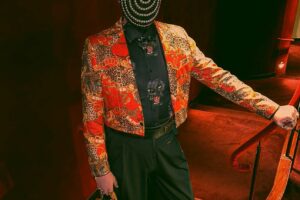

That history began in 1979 when Devia debuted at the Metropolitan Opera in the role of Gilda in Verdi’s Rigoletto.To this day her “Caro nome” ranks as the most sublime rendition of the aria I have ever experienced in the theater.
A 1980 Met broadcast of her Gilda.
And her last performance of the role in 2002.
Her Met career came to an end in 1994, after many notable performances including Lucia, Konstanze, Nannetta and Despina. A 1999 Adelia with OONY was the last time I heard her in New York until that 2014 Roberto Devereux.
For the record: I attended a 2003 staging of Donizetti’s Marino Faliero in Venice’s intimate Teatro Malibran, but aside from Devia’s account of Elena’s bravura “Tutto or morte,” that performance lingers less for its musical value than for the excessive preening of Rockwell Blake.
After reading Neil Rishoi’s recent exhaustive and illuminating post on the role of Norma, I then discovered there would be three Norma’s with the estimable septuagenarian in the title role at La Fenice. How could I resist the chance to see Devia in one of operas greatest roles in Venice? I could not.
After acquiring my ticket, the soprano announced that while she will continue to teach and concertize, these performances would be her farewell to staged opera. And so, I attended the Sunday, May 13, performance with bittersweet anticipation.
La Fenice’s production—new in 2015—is by American artist Kara Walker, who is listed as director, scenic and costume designer. Walker has set the opera not in Roman-occupied Gaul, but rather in an African colony under European subjugation. The director/designer explores race, sexuality, suppression and violence in her work, and it would appear, at least on paper, to be a perfect match of artist to subject matter.
Yet, this is one of the most disappointing stagings I have ever witnessed. Walker’s drawings and sketches for the production are emotionally and psychologically charged and far more evocative than anything in the final staging. Visually, there are impressive moments, particularly the stage curtain with its arresting image of a proud African woman.
And the backdrops—two which feature the artist’s signature silhouettes are used to distinguish a nocturnal sky and a jungle setting, and a third, which depicts an African mask and is used for ceremonial scenes—are especially striking.
But the stage is dominated by a giant African mask on its side, gazing upward. The contours of the mask provide two spatially limited areas: a flat area in front and an undulating hill behind. The limited playing area reduces the stage to little more than a concert venue.
Choruses are marched on and off with predictable regularity. Soloists bounce from stage left to stage right with the monotony and originality of a game of Pong. Walker presents a detailed concept in her program notes, but that conception does not translate from paper to stage. There is simply no interpersonal direction for the protagonists. The staging remains as flat as one of her silhouettes.
And then there are the costumes for the men’s chorus. When the curtain rose for Oroveso’s aria in the second scene of Act Two to reveal a tableau that was surely meant to elicit awe, the couple next to me guffawed. On stage-right bathed in crimson lighting, stood part of the men’s chorus bedecked in strapless red evening gowns, their hands placed seductively on their hips.
On stage-left, bathed in a blue light, another group was costumed in black and grey Klaus Nomi knock-offs. It gave me the feeling of a 1970s Colorforms collection gone awry.
Musically things began promisingly with a rhythmically urgent and propulsive Sinfonia under Riccardo Frizza’s baton, and his conducting and the playing from the orchestra proved an asset all evening. Tempi were beautifully realized and Frizza reveled in Bellini’s score. And I must make special mention of the chorus under Claudio Marino Moretti. They performed superbly all evening
As Oroveso, bass Luca Tittoto sang commandingly and managed to retain a sense of dignity despite being saddled with a costume that made him look like a villain from Indiana Jones and the Temple of Doom.
Tenor Stefan Pop has Alfredo, Roberto Devereux, Nemorino, the Duke in Rigoletto and the title role of Faust in his repertoire. I had therefore expected his Pollione to be more in synch with Bellini’s bel canto style than the dramatic voice type one usually (erroneously in my opinion) encounters in this role.
But Pop came out guns blazing. His singing was almost relentlessly loud and blunt. And the more pressure he put on his vocal production the less attractive it became. When not forcing, his singing was not without merit, but far too often the tenor resorted to needless shouting.
Unfortunately, I found little to admire in Carmela Remigio’s Adalgisa. The voice does not possess much individuality, color or warmth, and aside from an isolated high note here and there, the vocal rewards were slim. Both duets with Norma found her singing at its most responsive, but aside from those duets hers was not a satisfying performance.
Which left all of the heavy lifting to Mariella Devia as Bellini’s Priestess. The diminutive soprano—who turned 70 last month—did not disappoint. She towered over the rest of the cast, giving a master class in bel canto style and technique.
Devia didn’t tackle the role of Norma until she was 65, because, it seems, she was afraid the role’s declamatory recitatives and more dramatic passages would not be a good match for her vocally or dramatically. But after hearing her last week, I can’t help but wonder what might have been had she attempted the role earlier in her career.
Saturday’s opening recitative found a darker and more authoritative tone than I had expected. The subsequent “Casta Diva” revealed vestiges of the soprano’s hallmarks: pinpoint accuracy of pitch, limpidity of phrasing, extraordinary breath control and an instinctive understanding of a phrase’s architecture.
The syncopated high A’s to the high B-flat followed by that glorious descending phrase (that only Bellini could have written) was vintage Devia. At the end of the aria there was a momentary silence. Then a single cry of “REGINA!” rang out from the upper reaches of the house before the rest of the audience broke into applause.
The cabaletta “Ah! bello a me ritorno” that followed showed flashes of the soprano’s old brilliance. The ornamentations in the second verse were uniquely her own and succinct, the coloratura clean, the final high C blazing.
There were other moments to cherish; the phrase “Oh, cari accenti! Così li profferia, Così trovava del mio cor la via!” with its floated High A natural, the two duets with Adalgisa (both sung in key), and the “Ei tornerà” recitative with its double High C cadenzas. And surprisingly Devia more than held her own in the more dramatic “Oh non tremare” and trio that concludes Act One.
Did certain allowances have to be made? Of course. Lower passages were negotiated rather than conquered. The middle voice could turn dry in the recitatives. But even with these concessions what prevailed was an artist who inherently understood how the music is supposed to sound. It was a remarkable performance.
But ultimately, I was there to celebrate Devia who has informed and fostered my love of the bel canto repertoire more than any other artist. We may never see the likes of her again, and I felt privileged to witness her greatness one last time.
Regina, indeed!


























Comments